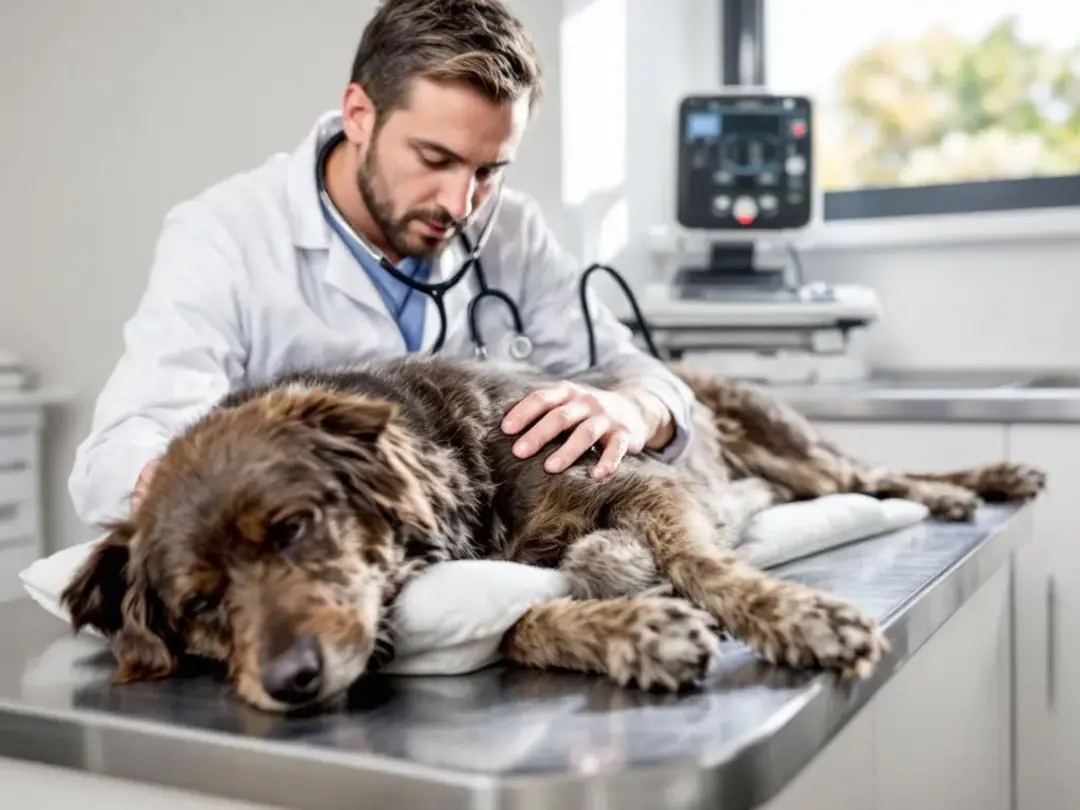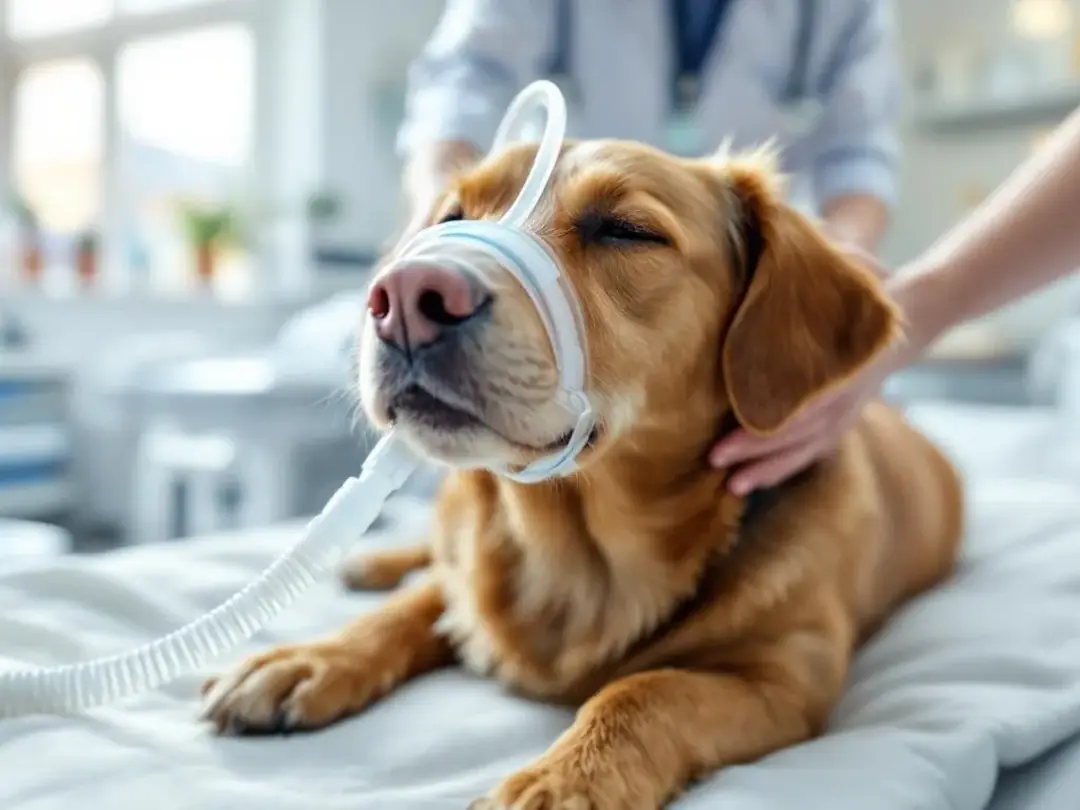Key Takeaways
-
Dog pneumonia is a serious respiratory infection causing inflammation in the lung's air sacs, requiring immediate veterinary attention
-
Common causes include bacterial infections (like Bordetella bronchiseptica), viral infections, aspiration of foreign material, and fungal pathogens
-
Early symptoms include deep wet cough, difficulty breathing, lethargy, fever, and nasal discharge that can progress to severe respiratory distress
-
Treatment typically involves antibiotics for bacterial pneumonia, supportive care including oxygen therapy, and hospitalization for severe cases
-
With prompt veterinary treatment, survival rates range from 77-94%, but early intervention is crucial for optimal outcomes
What Is Pneumonia in Dogs?
Pneumonia in dogs represents a serious lung infection that affects the alveoli-tiny air sacs responsible for oxygen exchange in your dog's lungs. When these crucial structures become inflamed and filled with fluid, your dog's respiratory system struggles to deliver adequate oxygen to vital organs, creating a potentially life threatening emergency.
The pathophysiology behind dogs pneumonia involves inflammatory cells infiltrating the lung tissue, disrupting normal gas exchange. As the infection spreads, fluid accumulates in the alveoli, preventing proper oxygen absorption and causing the characteristic breathing difficulties that alert owners to seek veterinary care.
Unlike mild respiratory illnesses such as kennel cough, pneumonia affects the lower respiratory tract and can rapidly progress from localized infection to severe pneumonia involving multiple lung lobes. The severity ranges from mild symptoms affecting single lung sections to complete respiratory failure requiring emergency intervention.
This respiratory illness rarely transmits from dogs to humans, but it remains highly contagious among dogs, especially in environments with poor ventilation or high animal density. The emergency nature of pneumonia cannot be overstated-many cases require immediate veterinary intervention due to the rapid progression potential that can lead to hypoxia and systemic complications.
Types and Causes of Dog Pneumonia
Understanding the various forms of pneumonia in dogs helps owners recognize risk factors and seek appropriate treatment for their pets. Each type presents unique challenges and requires specific therapeutic approaches.
Bacterial Pneumonia
Bacterial pneumonia represents the most common type affecting dogs, particularly targeting puppies, senior dogs, and immunocompromised dogs with weakened immune systems. This form of pneumonia develops when pathogenic bacteria invade the lower respiratory tract, causing severe inflammation and fluid accumulation.
Primary bacterial pathogens include Bordetella bronchiseptica-the same organism responsible for kennel cough-along with Streptococcus zooepidemicus, Escherichia coli, and Klebsiella species. These bacterial infections typically occur through inhalation of contaminated respiratory secretions, though aspiration events and bloodstream spread remain possible transmission routes.
Bacterial infectious pneumonia frequently develops as a secondary bacterial infection following viral respiratory illnesses or other underlying conditions that compromise the dog's immune system. The progression from upper respiratory symptoms to lower airway involvement often occurs rapidly, making early diagnosis crucial for optimal outcomes.
Viral Pneumonia
Viral pneumonia demonstrates high contagion rates among dogs and often involves multiple viral pathogens simultaneously attacking the respiratory system. Common causative viruses include canine influenza virus, parainfluenza, adenovirus type-2, and canine respiratory coronavirus.
High-risk environments such as dog parks, kennels, shelters, and daycare facilities with poor ventilation create ideal conditions for viral transmission. The viral infection initially damages respiratory tract defenses, frequently leading to secondary bacterial infections that require combination antibiotic therapy.
The compromised immune system following viral infection makes dogs particularly susceptible to developing bacterial pneumonia, creating complex cases requiring comprehensive treatment approaches.
Aspiration Pneumonia
Dogs aspiration pneumonia occurs when animals inhale vomit, food, medication, or foreign material into their lungs, causing direct tissue damage and creating an environment conducive to bacterial infection. This form accounts for approximately 23% of pneumonia cases in veterinary ICU patients.
Risk factors include esophageal disorders, frequent regurgitation, seizures, anesthesia complications, and laryngeal dysfunction that impairs normal swallowing reflexes. The mechanism involves stomach acid damaging delicate lung tissue, followed by secondary bacterial infection in the compromised areas.
Conditions predisposing dogs to aspiration include acid reflux, chronic bronchitis affecting swallowing coordination, and neurological disorders that impair normal protective reflexes during eating or drinking.
Fungal Pneumonia
Fungal pneumonia shows geographic prevalence in South and Southwest United States regions where specific environmental fungi thrive in soil and organic matter. Common pathogenic organisms include Blastomyces, Histoplasma, Coccidioides, and Cryptococcus species.
Exposure typically occurs near construction sites, areas with decaying organic matter, or locations contaminated with bird droppings containing fungal spores. These fungal infections create significant treatment challenges, requiring long-term antifungal medications with potential for relapse even after apparent recovery.
The chronic nature of fungal infections often results in subtle early symptoms that progress slowly, making accurate diagnosis more challenging than acute bacterial forms.
Parasitic and Protozoal Pneumonia
Less common but serious parasitic pneumonia develops when parasites establish residence and reproduce within lung tissue. Primary causes include heartworm disease, lungworms, and Pneumocystis organisms that create chronic respiratory inflammation.
Transmission occurs through contaminated feces, mosquito vectors carrying heartworm larvae, or direct contact with infected animals. Geographic variations in prevalence depend largely on vector distribution and environmental conditions supporting parasite lifecycles.
Inhalation and Toxic Pneumonia
This form results from breathing toxic fumes, smoke, chemicals, or irritant gases that directly damage respiratory tract tissues. Common exposures include household cleaners, paint fumes, wildfire smoke, and industrial chemicals that disrupt normal lung function.
The toxic particles interfere with natural mucus clearance mechanisms and impair oxygen processing, creating inflammation that can progress to secondary bacterial infection. Prevention focuses on avoiding exposure to known respiratory irritants and maintaining clean air quality in your dog's environment.


Clinical Signs and Symptoms
Recognizing pneumonia symptoms requires understanding the progressive nature of this respiratory illness, as signs often develop gradually before becoming severe enough to prompt immediate veterinary attention.
Early Stage Symptoms
The initial presentation typically involves a deep, wet-sounding cough that may be intermittent and easily dismissed as minor irritation. This productive cough differs significantly from the dry, honking sound associated with kennel cough, producing moisture or discharge that indicates lower airway involvement.
Early exercise intolerance manifests as reduced activity levels and reluctance to engage in normal play or walking routines. Subtle changes in breathing pattern, particularly increased respiratory rate during rest, may be the first indication of developing lung infection.
Decreased appetite and mild lethargy often accompany these early respiratory signs, though owners might initially attribute these changes to other factors such as weather changes or minor stress.
Progressive Symptoms
As the infection advances, the persistent productive cough becomes more frequent and may produce blood-tinged or discolored sputum. The difficulty breathing becomes obvious, with increased respiratory effort and mouth breathing replacing normal nasal breathing patterns.
Fever development ranges from 102.5°F to 106°F (39.2°C to 41.1°C), creating systemic illness that affects your dog's overall demeanor and energy levels. Nasal discharge appears, varying from clear to yellow or green depending on the type of infection and secondary bacterial involvement.
Significant lethargy and depression accompany the physical symptoms, with affected dogs showing reluctance to move, play, or engage in normal activities. The rapid breathing becomes more pronounced, especially during minimal exertion or stress.
Severe Stage Symptoms
Critical cases present with obvious respiratory distress characterized by rapid, shallow breathing and potential cyanosis-a bluish discoloration of gums indicating inadequate oxygen levels. Some dogs develop orthopnea, meaning they cannot breathe comfortably unless sitting upright.
Complete loss of appetite and severe dehydration compound the respiratory crisis, while some dogs may experience collapse or extreme weakness requiring emergency veterinary intervention. These severe symptoms indicate life threatening complications that demand immediate professional treatment.
Diagnostic Procedures
Accurate diagnosis of pneumonia requires a systematic approach combining clinical assessment, advanced imaging, and laboratory testing to identify the specific cause and severity of infection.
Physical Examination
The initial veterinary assessment begins with temperature measurement to detect fever indicating active infection. Lung auscultation reveals abnormal sounds including crackles, wheezes, or diminished breath sounds that suggest fluid accumulation or inflammation.
Respiratory rate and effort evaluation helps assess the degree of distress, while overall body condition assessment includes hydration status and mucous membrane color evaluation. The physical examination provides crucial baseline information for treatment planning and monitoring.
Diagnostic Imaging
Chest X-rays represent the gold standard for visualizing pneumonia, showing characteristic alveolar patterns, consolidation, or fluid accumulation within affected lung regions. Three-view radiographs including lateral and two dorsoventral projections provide comprehensive evaluation of all lung fields.
Advanced imaging with CT scans becomes necessary for complex cases or when foreign body aspiration is suspected. Thoracic ultrasound offers additional information for peripheral lung lesions and can guide sampling procedures for diagnostic testing.
The radiographic changes help differentiate pneumonia from other respiratory conditions and provide objective measures for monitoring treatment response over time.
Laboratory Testing
Complete blood count analysis reveals neutrophilia, left shift, and toxic changes in white blood cells that indicate active bacterial infection. Blood chemistry panels assess organ function and identify underlying conditions that may predispose to pneumonia development.
Blood gas analysis measures oxygen levels and acid-base balance, providing critical information about the severity of respiratory compromise. Pulse oximetry offers non-invasive oxygen saturation monitoring during diagnostic procedures and treatment.
These laboratory tests help guide treatment decisions and establish baseline values for monitoring your dog's recovery progress.
Airway Sampling and Culture
Bronchoalveolar lavage (BAL) serves as the gold standard for definitive pneumonia diagnosis, allowing direct sampling of lower airway secretions for microscopic examination and culture. When BAL is not feasible due to patient instability, tracheal wash provides an alternative sampling method.
Cytology examination reveals septic suppurative inflammation with intracellular bacteria, confirming infectious pneumonia diagnosis. Bacterial culture and sensitivity testing enables targeted antibiotic selection for optimal treatment outcomes.
Specialized testing including Mycoplasma and anaerobic cultures becomes necessary when standard treatments fail or clinical presentation suggests unusual pathogens.


Treatment Approaches
Successful pneumonia management requires a multifaceted approach combining appropriate antimicrobial therapy with comprehensive supportive care tailored to individual patient needs and disease severity.
Antibiotic Therapy
Empiric therapy typically begins with broad-spectrum antibiotics such as amoxicillin-clavulanic acid or doxycycline before culture results become available. This approach covers common bacterial pathogens while laboratory testing identifies specific organisms and their antibiotic sensitivities.
Targeted therapy based on culture-guided results allows for specific antibiotic selection that maximizes effectiveness while minimizing resistance development. Severe cases often require combination therapy using dual antibiotics such as amoxicillin plus enrofloxacin for enhanced bacterial coverage.
Treatment duration has evolved from traditional 3-6 week courses to evidence-based 10-14 day protocols in many cases, with recent studies supporting shorter duration therapy for appropriate patients. Regular reevaluation at 10-14 days with radiographic follow-up ensures adequate treatment response.
Intravenous antibiotics become necessary for hospitalized patients with severe pneumonia or those unable to tolerate oral medications due to vomiting or severe illness.
Supportive Care
Oxygen therapy provides life-saving support for hypoxemic patients using various delivery methods including masks, chambers, or nasal cannulas depending on patient tolerance and oxygen requirements. Supplemental oxygen helps maintain adequate tissue oxygenation while pneumonia treatment addresses the underlying infection.
Fluid therapy maintains proper hydration and supports circulation, particularly important for dogs with fever, decreased oral intake, or dehydration from increased respiratory effort. Careful fluid balance prevents pulmonary edema while ensuring adequate perfusion of vital organs.
Nebulization treatments using saline or medications help mobilize respiratory secretions, making them easier to cough up and clear from the airways. Steam treatment provides similar benefits and can be administered at home under veterinary guidance.
Coupage, or chest percussion, assists with secretion clearance by mechanically loosening accumulated material in the airways. Anti-inflammatory medications help manage fever and pain when appropriate for individual patients.
Hospitalization Criteria
Severe respiratory distress requiring continuous oxygen supplementation necessitates hospital monitoring and intensive care management. Dogs unable to maintain adequate hydration or nutrition due to illness severity require intravenous support and monitoring.
The need for intensive monitoring and round-the-clock care determines hospitalization for critically ill patients. Failure to respond to outpatient treatment within 48-72 hours indicates the need for more aggressive intervention and closer monitoring.
Prognosis and Recovery
Understanding expected outcomes helps owners make informed decisions about treatment while maintaining realistic expectations for their dog's recovery timeline and potential complications.
Survival Rates
Overall survival rates for bacterial pneumonia range from 77-94% with appropriate veterinary care and prompt treatment initiation. Aspiration pneumonia carries approximately 81.6% survival rate when treated promptly and aggressively.
Factors affecting prognosis include patient age, immune status, presence of underlying diseases, and pathogen virulence. Immunocompromised dogs and those with concurrent medical conditions face increased risks for complications and slower recovery.
Multidrug-resistant bacterial infections significantly reduce survival rates and require aggressive therapy with alternative antibiotics and intensive supportive care.
Recovery Timeline
Initial improvement typically appears within 48-72 hours of starting appropriate treatment, with reduced fever, improved appetite, and decreased respiratory effort indicating positive response. However, complete radiographic resolution may take 2-6 weeks depending on infection severity and patient factors.
Most dogs return to normal activity levels within 3-5 weeks of treatment initiation, though some may require extended recovery periods for complete lung healing. Regular follow-up care continues until complete resolution is confirmed through clinical examination and imaging studies.
The dog's recovery depends heavily on early intervention, appropriate antibiotic selection, and comprehensive supportive care throughout the treatment period.


Prevention Strategies
Effective pneumonia prevention requires a comprehensive approach addressing vaccination, environmental management, and overall health maintenance to reduce risk factors and strengthen natural disease resistance.
Vaccination Programs
Core vaccines including distemper, adenovirus-2, and parainfluenza provide protection against common viral causes of respiratory illness that can predispose to secondary bacterial infections. These vaccinations form the foundation of respiratory disease prevention.
Non-core vaccines such as Bordetella and canine influenza become important for dogs at higher risk due to lifestyle factors including boarding, daycare attendance, or frequent contact with other dogs. The kennel cough vaccine particularly benefits dogs in high-density environments.
Annual booster vaccinations maintain protective immunity levels, though some vaccines may require more frequent administration based on risk assessment and veterinary recommendations.
Environmental Management
Avoiding overcrowded, poorly ventilated areas with high dog populations reduces exposure to infectious agents that cause pneumonia. Well-ventilated spaces with good air circulation help dilute and remove airborne pathogens.
Maintaining clean living environments through regular disinfection of bedding, food bowls, and water containers eliminates potential sources of bacterial contamination. Proper waste management prevents accumulation of infectious material.
Minimizing exposure to construction sites and areas with high fungal spore concentrations protects against environmental pneumonia causes. Awareness of regional fungal risks helps owners make informed decisions about activity locations.
Health Maintenance
Regular veterinary check-ups enable early detection of respiratory issues and underlying conditions that predispose to pneumonia development. Preventive care identifies problems before they progress to serious illness.
Maintaining optimal body weight and providing regular exercise supports immune system function and overall respiratory health. Proper nutrition supplies essential nutrients needed for disease resistance and tissue repair.
Prompt treatment of underlying conditions such as acid reflux, esophageal disorders, or chronic bronchitis reduces aspiration pneumonia risk. Managing predisposing factors prevents many cases of secondary pneumonia.
When to Seek Emergency Care
Recognizing critical warning signs enables owners to seek immediate veterinary attention when their dog's condition requires emergency intervention rather than routine appointment scheduling.
Severe difficulty breathing, blue gums, or collapse indicate life threatening respiratory compromise requiring immediate professional intervention. These symptoms suggest inadequate oxygen delivery to vital organs and potential respiratory failure.
Persistent high fever above 104°F (40°C) not responding to treatment indicates severe systemic illness that may require intensive care management. Uncontrolled fever can lead to organ damage and treatment complications.
Inability to eat or drink for more than 24 hours combined with respiratory symptoms suggests severe illness requiring immediate evaluation and supportive care. Dehydration compounds respiratory distress and delays recovery.
Rapid worsening of symptoms despite appropriate treatment indicates treatment failure, drug resistance, or complications requiring immediate medical reassessment and potential hospitalization.
FAQ
Can my dog get pneumonia from being outside in cold weather?
Cold weather alone doesn't cause pneumonia, but it can stress the immune system and make dogs more susceptible to respiratory infections. The actual cause is usually bacterial, viral, or fungal pathogens rather than temperature exposure. However, prolonged exposure to cold, wet conditions can weaken your dog's natural defenses against these infectious agents.
How long should I isolate my dog if they have infectious pneumonia?
Dogs with infectious pneumonia should be isolated from other dogs until they've been on appropriate antibiotics for at least 48-72 hours and symptoms are improving. Your veterinarian will provide specific guidance based on the type of infection. Some viral forms may require longer isolation periods, while bacterial cases typically become non-contagious more quickly with proper treatment.
Is it safe to give my dog over-the-counter cough suppressants for pneumonia?
No, cough suppressants are generally contraindicated in pneumonia cases because coughing helps clear infected material from the lungs. Suppressing this natural protective mechanism can actually worsen the infection by allowing secretions to accumulate. Only use medications prescribed specifically by your veterinarian who can determine what's appropriate for your dog's specific condition.
Can indoor dogs still get pneumonia?
Yes, indoor dogs can develop pneumonia from aspiration, exposure to household irritants, or from contact with infected animals during vet visits or brief outdoor exposure. Being indoors reduces but doesn't eliminate pneumonia risk. Aspiration pneumonia can occur from vomiting, acid reflux, or improper medication administration regardless of living environment.
What's the difference between kennel cough and pneumonia in dogs?
Kennel cough typically affects the upper respiratory tract with a dry, honking cough and mild symptoms, while pneumonia involves the lower respiratory tract with wet cough, difficulty breathing, and more severe systemic signs like fever and lethargy. Kennel cough may progress to pneumonia if left untreated or in immunocompromised dogs, but they represent different severities of respiratory illness requiring different treatment approaches.






